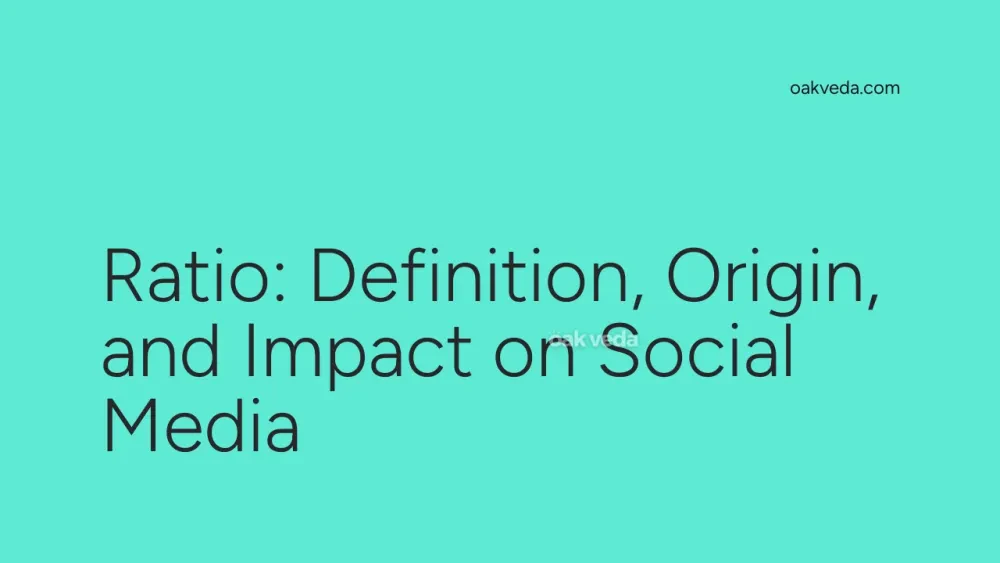
What is Ratio?
In the context of social media, a "ratio" refers to a situation where a post receives significantly more replies or comments compared to likes, shares, or retweets. This imbalance typically indicates that the original post has sparked controversy, disagreement, or criticism among users. When a post is said to be "ratioed," it suggests that the content has generated more negative responses than positive engagement.
Origin and Development of Ratio
The term "ratio" in social media originated on Twitter around 2017. It emerged from users observing the disproportionate number of replies to likes or retweets on controversial tweets. The concept quickly spread to other platforms, becoming a widely recognized indicator of a post's reception.
How Ratio Works
A ratio occurs when:
- A user posts content on a social media platform
- The post receives an unusually high number of replies or comments
- The number of replies significantly outweighs the number of likes, shares, or positive interactions
The exact threshold for what constitutes a ratio can vary, but generally, when the number of comments exceeds the number of likes by a considerable margin, the post is considered "ratioed."
Types or Variations of Ratio
While the basic concept of ratio remains consistent, there are some variations:
- Comment Ratio: The classic form, where comments outnumber likes or shares
- Quote Tweet Ratio: On Twitter, when quote tweets (retweets with comments) outnumber regular retweets
- Ratio Baiting: Intentionally posting controversial content to provoke a ratio response
Popular Examples of Ratio
Some notable examples of ratio include:
- Political figures' tweets that receive widespread criticism
- Brand messages that are perceived as tone-deaf or insensitive
- Celebrities' statements on controversial topics
These instances often go viral, with users actively participating in the ratio to express their disapproval.
Impact of Ratio on Social Media Culture
The concept of ratio has significantly influenced online discourse:
- Public Opinion Indicator: Ratios serve as a quick gauge of public sentiment towards a statement or idea.
- Accountability Tool: They can hold individuals and organizations accountable for their words and actions.
- Content Moderation: Some platforms now consider ratio as a factor in their content moderation algorithms.
- Meme Culture: "Getting ratioed" has become a meme in itself, often used humorously or sarcastically.
Controversies or Debates Surrounding Ratio
While ratio can be an effective way to measure public response, it's not without controversy:
- Echo Chambers: Critics argue that ratios can reinforce echo chambers and groupthink.
- Harassment Concerns: Some worry that the concept encourages pile-ons and online harassment.
- Manipulation: There are concerns about the potential for artificial manipulation of ratios through coordinated efforts or bots.
How Brands and Influencers Use Ratio
Savvy social media users have learned to navigate the ratio phenomenon:
- Avoiding Ratios: Brands and influencers often carefully craft messages to avoid potential ratios.
- Damage Control: When faced with a ratio, quick responses and apologies are common strategies.
- Leveraging Positive Ratios: Some deliberately seek positive ratios (more likes than comments) as a sign of approval.
Future Trends Related to Ratio
As social media continues to evolve, so too will the concept of ratio:
- Platform Adaptations: Social media platforms may introduce features to highlight or mitigate ratios.
- AI Analysis: Advanced AI could provide more nuanced analysis of ratios and sentiment.
- Ratio Literacy: As users become more aware of ratios, their significance and interpretation may change.
FAQs about Ratio
-
Is a ratio always negative? While ratios are typically associated with negative responses, a positive ratio (significantly more likes than comments) can indicate strong approval.
-
Can a ratio be manipulated? Yes, coordinated efforts or bot activity can artificially create or amplify a ratio.
-
Do all social media platforms experience ratios? While the term originated on Twitter, the concept applies to any platform where users can comment on and like posts.
-
How can I avoid getting ratioed? Be mindful of your content, consider your audience, and avoid controversial statements without proper context or sensitivity.
-
Is ratio a reliable measure of public opinion? While ratios can provide insight, they shouldn't be considered a definitive measure of public opinion, as they can be influenced by various factors and may not represent a diverse range of perspectives.
Understanding the concept of ratio in social media is crucial for navigating today's digital landscape. Whether you're a casual user, a brand manager, or a social media professional, being aware of ratios can help you better interpret online conversations and gauge public sentiment. As social media continues to shape public discourse, the significance of phenomena like ratio will likely continue to evolve and impact how we communicate online.
You may be interested in:
- GRWM: Definition, Origin, and Impact on Social Media
- Tea: Definition, Origin, and Impact in Social Media Culture
- Trending: Definition, Origin, and Impact on Social Media
- Social Sets: Definition, Origin, and Impact on Social Media Management
- 1437: Definition, Origin, and Impact on Social Media
- BFR: Definition, Origin, and Impact on Social Media

